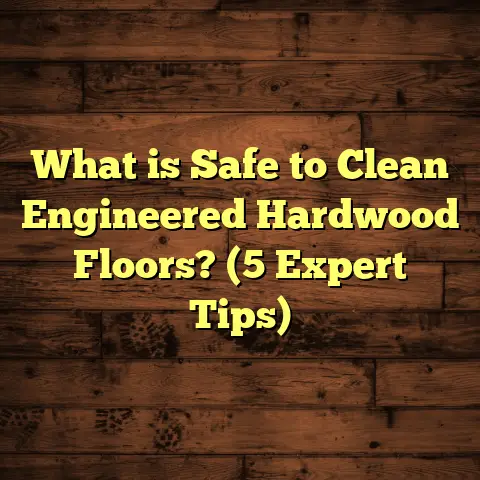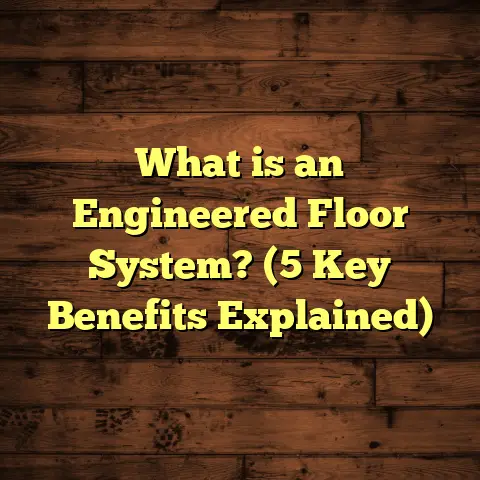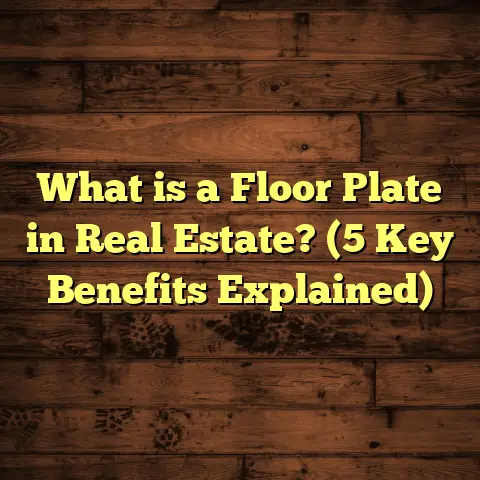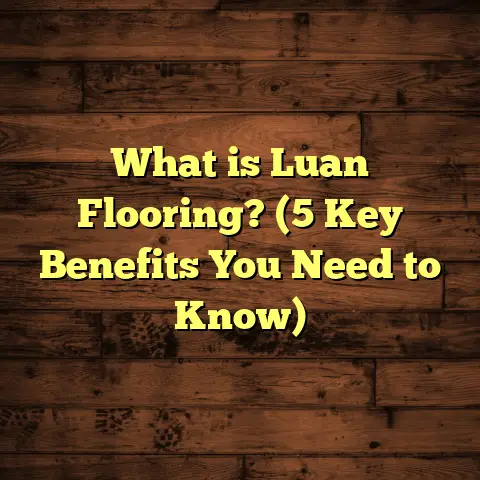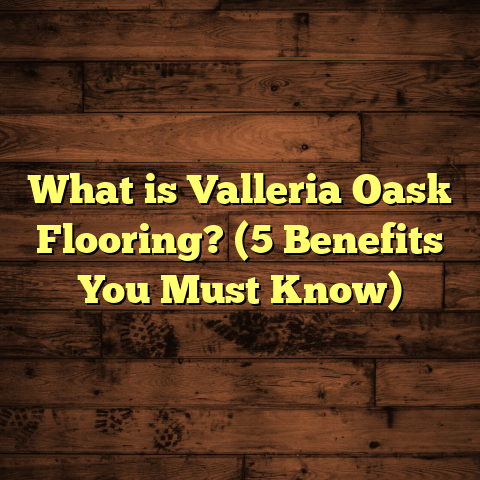What is LVT Flooring Cost? (5 Key Factors You Must Know)
When I think about flooring, the first thing that hits me is how much it shapes the entire vibe of a room. Flooring really sets the tone—it can make a space cozy and inviting or sleek and modern. Over the years, I’ve worked with many different types of floors, but Luxury Vinyl Tile (LVT) has always stood out to me because it offers a fantastic blend of style and function. Its ability to mimic natural materials like wood or stone while being practical and durable is impressive. But one question I get asked all the time, whether from homeowners or contractors, is: What exactly does LVT flooring cost? Today, I want to walk you through exactly what impacts that price, based on my personal experience and detailed research.
What is LVT Flooring?
Before talking numbers, let’s make sure we’re on the same page about what LVT actually is.
Luxury Vinyl Tile (LVT) is a type of vinyl flooring that’s designed to look like natural flooring materials such as hardwood, stone, or ceramic tile. Unlike traditional vinyl sheets that come in large rolls, LVT comes in individual planks or tiles you can arrange in various patterns. That gives you a lot of design freedom.
I remember when LVT started gaining traction in the early 2010s. At first, some people were skeptical—how could vinyl possibly look like real wood or stone? But thanks to advances in printing and manufacturing technology, LVT now comes with ultra-realistic textures and colors that mimic natural materials almost perfectly. When I installed my first LVT floor, I was genuinely surprised by how natural it looked underfoot.
Here are a few key points about LVT:
- Visual Appeal: Thanks to digital printing and embossing techniques, LVT captures the grain patterns of wood and veining of stone in great detail.
- Durability: LVT has a wear layer that protects against scratches, stains, and dents. Many products come with warranties ranging from 10 to 25 years.
- Water Resistance: Unlike hardwood floors, most LVT options are waterproof or highly water-resistant, making them suitable for kitchens, bathrooms, basements, and even commercial spaces.
- Installation: You can install LVT as a glue-down product or a floating floor with click-lock edges. This makes it popular among DIYers and professionals alike.
- Comfort: LVT tends to be softer underfoot compared to tile or hardwood, which can make a big difference during long periods of standing.
So why is it becoming such a popular choice? It’s because it balances beauty with practicality. If you’re looking for a floor that looks great but can handle kids, pets, spills, and heavy use without breaking the bank, LVT often fits the bill.
Now let’s move on to the part you really want to know about — cost.
What Determines LVT Flooring Cost? 5 Key Factors
From my years installing floors in diverse settings—from small apartments to sprawling commercial projects—I’ve seen how variable LVT costs can be. It’s not just about the price per square foot printed on the box. Several factors influence what you’ll actually pay.
Here are the five main elements that affect LVT flooring cost:
1. Quality of Material and Brand Choice
Not all LVT is created equal—and the price difference reflects that.
You can find budget-friendly LVT at around $2 per square foot, but these products often have thinner wear layers and may look less realistic. On the other hand, premium brands offer thick wear layers (sometimes up to 30 mil or more), realistic embossing textures, and extended warranties—sometimes up to 25 years.
From experience, clients who opt for higher-quality LVT tend to be happier in the long run. Lower-cost tiles may look fine when installed but can wear out faster or fade under sunlight.
Here’s a quick breakdown based on my observations:
| Quality Level | Typical Material Cost per Sq Ft | Features |
|---|---|---|
| Entry-Level | $2 – $3 | Thin wear layer (6-12 mil), basic design options |
| Mid-Range | $3.50 – $5 | Moderate wear layer (12-20 mil), better textures |
| Premium | $5 – $8+ | Thick wear layer (20-30+ mil), ultra-realistic design |
I once installed a mid-range LVT floor for a family’s kitchen that had a deep wood grain texture. They loved it because it looked like real hardwood but was way easier to clean. They told me that even after two years with kids and pets running around, it still looked brand new.
2. Installation Method Matters
The way you install your LVT floor impacts cost significantly.
There are two main ways to install LVT:
- Glue-down: The tiles are glued directly to the subfloor.
- Floating/Click-Lock: The tiles lock together and “float” above the subfloor without glue.
Glue-down installation generally costs more because it requires more prep work — cleaning and leveling the subfloor thoroughly — plus more time applying adhesive. Labor costs here often run $3-$5 per square foot.
Floating floors are usually less labor-intensive and can be installed over existing floors if they’re smooth enough. Labor costs for floating systems might be closer to $1.50-$3 per square foot.
If you’re considering DIY installation, floating click-lock systems are generally easier for beginners.
On a recent project for a retail store client, we used glue-down installation because the traffic would be heavy. It raised labor costs but gave them a very stable floor that won’t shift over time.
3. Size and Shape of Your Space
How big your room is obviously impacts total cost — more square footage means more material and labor. But shape also plays a role.
Rooms with lots of corners, angles, or odd shapes require extra cutting and fitting during installation. That adds labor hours and waste material.
For example, I worked on an older home with a sunroom that had multiple corners and built-in benches. The cuts were intricate enough that installation took about 30% longer than for a simple rectangular room.
If your layout is straightforward (like an open living room), you’ll save on labor compared to rooms with complex layouts or multiple doorways.
4. Subfloor Condition & Preparation
This is one factor people often overlook until after they get their estimate — but it can be a big cost driver.
LVT needs a flat, clean subfloor free of moisture problems. If your floor has cracks, bumps, or water damage from past leaks, those issues must be fixed before installation.
In one older home I worked on last year, we had to level several uneven spots in the concrete slab and install a moisture barrier before laying down the vinyl tiles. Those repairs added roughly $1-$2 per square foot in prep costs.
If you skip this step or do it poorly, your floor might warp or tiles could come loose quickly — which ends up costing way more in repairs later.
5. Waste Factor & Additional Materials
You’ll need more than just tiles to finish your project. There’s underlayment (sometimes required), adhesives if gluing down, trim pieces for edges, transition strips between rooms, and baseboards or quarter rounds.
Also, cutting tiles to fit corners or edges produces waste — typically 5%-10% extra material is recommended to cover this loss.
I always advise clients to plan for extra material upfront rather than ordering exactly what they measure — it saves headaches mid-installation.
Breaking Down Costs: Real Project Examples
To give you an even clearer picture of what you might spend on an LVT project, here are some examples from real jobs I’ve done recently:
| Project Type | Material Cost ($/sq ft) | Installation Cost ($/sq ft) | Prep & Extras ($/sq ft) | Total Cost ($/sq ft) | Notes |
|---|---|---|---|---|---|
| Small Bathroom | $3 | $2.50 | $1 | $6.50 | Moisture barrier needed |
| Living Room | $4 | $3 | $0.75 | $7.75 | Floating installation |
| Retail Store | $5.50 | $4 | $1.50 | $11 | Glue-down for heavy traffic |
| Kitchen | $3.75 | $3.50 | $1.25 | $8.50 | Complex layout & prep |
These figures show how wide-ranging costs can be depending on your situation.
How Does LVT Compare to Other Flooring Types?
Sometimes people ask me if LVT is “worth it” compared to cheaper laminate or traditional vinyl sheet flooring.
Here’s what I usually say:
- Laminate flooring tends to be less water-resistant and can swell if exposed to moisture.
- Sheet vinyl is often cheaper but doesn’t have the same realistic look or durability as LVT.
- Hardwood looks amazing but costs much more upfront ($8-$15+ per sq ft) and requires careful maintenance.
- Tile is durable but cold and hard underfoot; installation is more expensive too.
LVT strikes a balance — you get waterproofing, durability, comfort underfoot, and great looks all at a mid-range price point.
Personal Stories: Why I Recommend LVT
One project I really enjoyed was working with a young family who wanted stylish flooring but had two energetic kids and a dog. Hardwood was off the table because they worried about scratches and spills.
We chose a mid-range wood-look LVT with a thick wear layer and installed it floating over their existing subfloor. The family loved how easy it was to clean up after spills and how no one noticed scratches after months of use.
Another time, I installed stone-look LVT for a boutique coffee shop owner who wanted an upscale vibe without the cost of natural stone tile. The result was stunning and within budget.
These experiences taught me that LVT offers real versatility across different lifestyles and spaces.
Tips for Saving Money Without Sacrificing Quality
If you’re excited about LVT but concerned about price tags, here are some practical tips I share with clients:
- Shop around: Prices vary between stores and brands—don’t just buy from the first place.
- Consider DIY installation: Click-lock systems are designed for beginners.
- Prep subfloor yourself: Minor leveling or cleaning can reduce professional labor time.
- Order extra material upfront: Avoid costly delays by having enough stock.
- Get multiple quotes: Compare installers’ prices and reviews carefully.
- Ask about warranties: Sometimes paying slightly more upfront gets you better protection long-term.
More About Installation: What You Should Expect
When hiring pros for installation, expect them to do these steps:
- Inspect subfloor for moisture and level issues.
- Prepare surface, including repairs or moisture barriers if needed.
- Lay underlayment if required by your product.
- Install tiles/planks, cutting pieces as necessary.
- Finish edges with trims or molding.
- Clean up thoroughly after job completion.
Good installers charge fairly for this detailed work because skipping steps leads to problems later on.
Maintenance Costs: What Comes After Installation?
One of the reasons people choose LVT over other floors is its low maintenance needs:
- Just sweep or vacuum regularly.
- Mop occasionally with a damp mop (avoid soaking).
- Avoid harsh chemicals or abrasive scrubbing.
- Repair minor scratches by replacing individual tiles if necessary (easier than hardwood planks).
I’ve seen clients save hundreds over years on cleaning products compared to carpet or hardwood upkeep.
Environmental Impact: Is LVT Eco-Friendly?
This question comes up frequently now as people focus more on sustainability.
LVT isn’t biodegradable like natural wood but many manufacturers now use recycled materials in production or have take-back programs for old flooring.
If eco-impact matters to you:
- Look for certifications like FloorScore (low VOC emissions).
- Ask suppliers about recycled content.
- Consider longevity—lasting floors reduce waste over time.
Final Thoughts on Cost vs Value
LVT flooring cost depends on many factors beyond just price per square foot: material quality, installation complexity, room shape, subfloor prep needs, and extras like trims add up quickly.
But when you weigh initial investment against durability, maintenance savings, water resistance, style options, and comfort—it’s an excellent value choice for many homes and businesses.
I hope this detailed breakdown helps you understand what goes into pricing LVT flooring so you can plan confidently for your project.
If questions pop up about brands, installation tips, or budgeting strategies feel free to ask me anytime—I’m here to help make your flooring journey easier!
Additional Resources I Use:
If you want precise estimates tailored for your local area or specific project details, tools like FloorTally can help you calculate costs quickly using local labor and material rates plus waste factors included.
Thank you for sticking with me through this detailed walkthrough! Now you know everything I wish someone told me when I first started working with LVT floors—and hopefully you’re ready to make smart choices for your own space without surprises in cost or quality.
